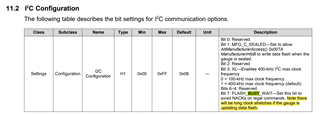Other Parts Discussed in Thread: BQ27220
Hi Team,
1, Client receives "NACK" while reading data. The customer configures FLASH_BUSY_WAIT=0, is it normal to receive NACK? If the client receives NACK, how long is the recommended delay for the client to visit gauge again? Is there a maximum busy time?

2. Which configuration method of FLASH_BUSY_WAIT is more popular? Or more reasonable?
3. If FLASH_BUSY_WAIT=1 is configured, then when the data flash is busy, Clock Stretching will occur. Whether the stretching action will be kept until data flash free. Are there risks if it takes too long?
4. The customer reads the temperature every 50ms under some working conditions. Is there a minimum read interval for the device to work properly? Are there different access intervals when reading data such as SOC, current?
5. It can be seen from the TRM that the update speed of voltage, current and temperature in Normal mode seems to be 1s each time. Does it make no sense to update every 50mS?

Regards,
HL


